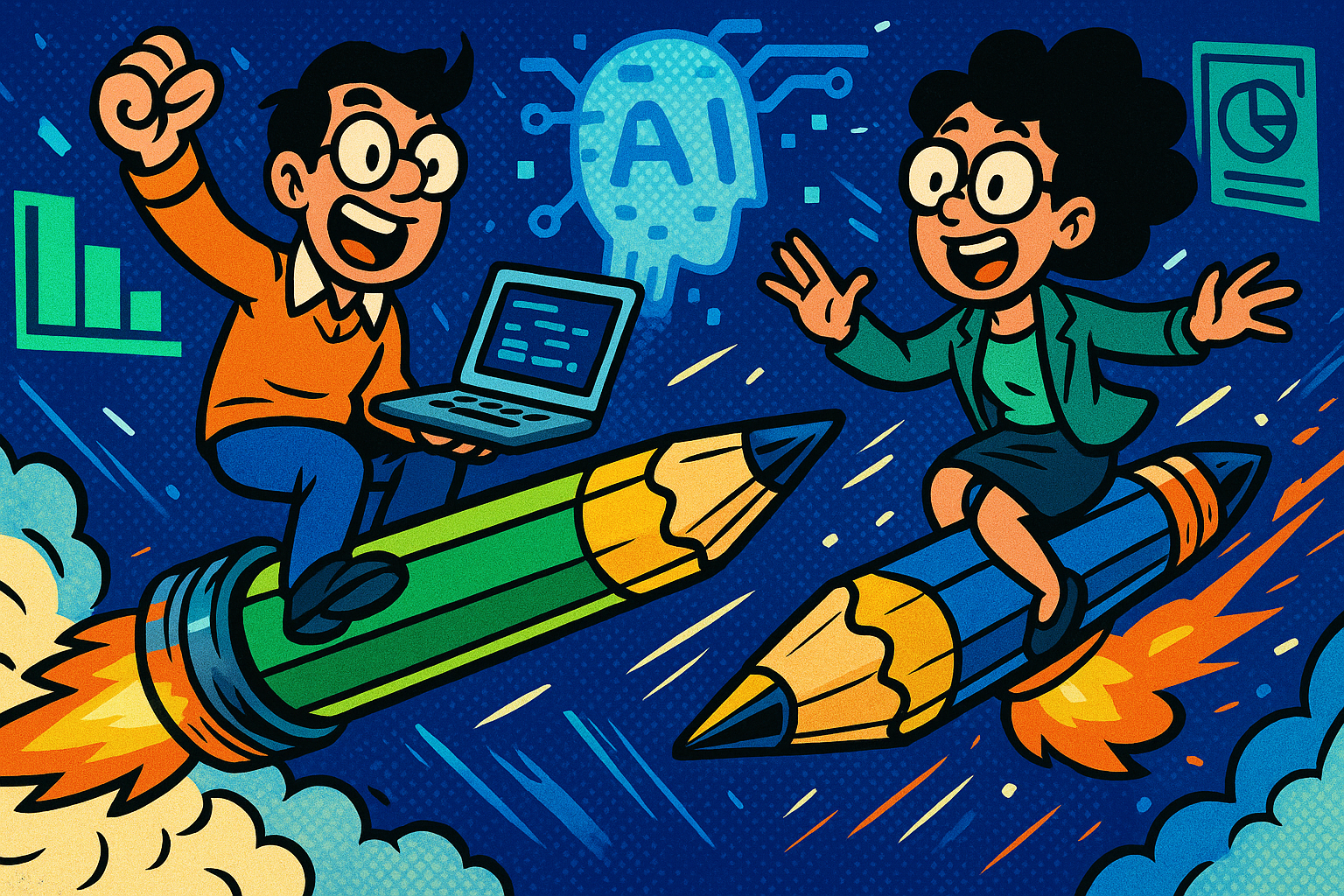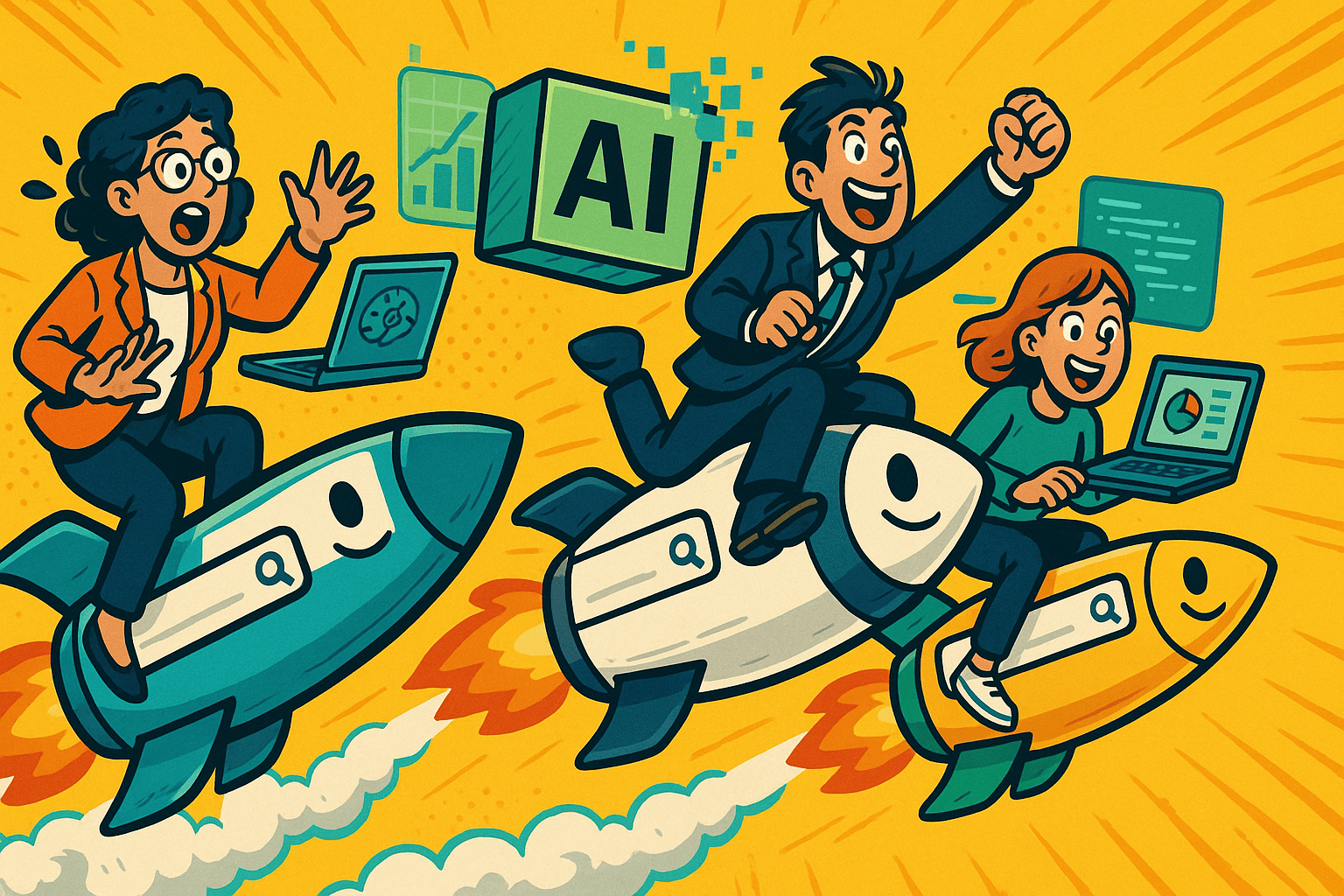Google’s Helpful Content Update (HCU) shifted the rules of SaaS SEO. The update prioritizes content that demonstrates authentic expertise and penalizes anything that looks mass-produced or unhelpful. For SaaS marketers, this means AI-generated blogs are no longer safe by default.
💡 The risks are clear
- AI content often lacks E-E-A-T (Experience, Expertise, Authoritativeness, Trust), a gap you can close by aligning your workflow with does E-E-A-T still matter guidance.
- Repetition and “boilerplate” phrasing can trigger spam signals, so layer an automated QA sweep with AI-powered content auditing tools before anything ships.
- Scaled automation without oversight risks ranking drops and loss of credibility; when you need guardrails and governance, tap SaaS SEO professionals to formalize editorial standards.
Table of Contents
For growth-stage SaaS companies, the challenge is balance. They need the performance of AI tools but can’t sacrifice trust signals or long-term organic acquisition.
▶️ The winning approach is AI + human oversight, where AI supports scale and ideation, human editors ensure compliance with Google’s standards, and SEO strategy aligns automation with business growth. When you’re ready to operationalize this, Book a call with The Rank Masters.
The Safest AI Writing Tools for SaaS SEO in 2025
Choosing the right AI tool is no longer just about speed, it’s about SEO safety, scalability, and compliance with Google’s Helpful Content Update (HCU). Below is a comparison of five leading AI platforms that SaaS teams can rely on for growth without risking rankings.
| Tool | G2 Rating | Strengths | Drawbacks | Pricing Plan |
|---|---|---|---|---|
| Jasper AI | 4.7/5 ★ (1,000+ reviews) | Strong brand voice memory, SEO workflows, integrates with Surfer SEO; excellent for scaling SaaS blogs. | Can feel “templated” if prompts are weak; requires human editing for EEAT. | $49+ per month (Creator) |
| Surfer SEO AI | 4.8/5 ★ (537 reviews) | Real-time optimization, content scoring, audit tool for SaaS pages; SERP-driven insights for safe SEO. | Pricing steep for small teams; focused on text, not visuals or multimedia. | $59+ per month (Basic) |
| Writer.com | 4.6/5 ★ (350+ reviews) | Enterprise governance, compliance guardrails, integrates with style guides; AI outputs safer for SEO. | Geared to larger SaaS orgs; learning curve for smaller teams. | $18+ per user/month (Team) |
| Copy.ai | 4.7/5 ★ (500+ reviews) | Great for ideation, blog drafts, SaaS product messaging; unlimited words in most plans. | Less advanced SEO scoring; can generate repetitive phrasing. | Free plan, $49+ per month (Pro) |
| Frase | 4.6/5 ★ (G2), 4.8/5 ★ (Capterra) | All-in-one content briefs + AI assistant; strong for FAQs/snippets; SaaS-specific FAQ generation. | Content scoring not as deep as Surfer/Clearscope; UI less polished. | $45+ per month (Individual) |
How Do I Choose an AI Writing Tool That’s Safe For SaaS SEO?
Choosing the right AI writing tool for SaaS SEO isn’t just about features (it’s about aligning the tool with Google’s standards and your team’s workflow).
Here’s a framework you can use:
Step 1 — Define your SEO priorities
Are you optimizing for long-form, educational SaaS blogs, or faster short-form content? Tools built for enterprise-scale blogging often differ from those geared toward ad copy or email.
Step 2 — Evaluate compliance features
Does the tool flag duplication risks? Shortlist platforms or set up QA using content audit software with AI so thin or repetitive sections are caught before publishing. Can it integrate author attribution, citations, or editorial controls that reinforce E-E-A-T? For governance, align your checklist to does E-E-A-T still matter so you’re screening for the right quality signals.
Step 3 — Check integration with your stack
Safe tools should connect with your CMS, SEO platforms, and editorial processes. If your workflows also need on-page conversion improvements, consider SaaS content marketing services to stitch production, optimization, and CRO together.
Step 4 — Validate with proof, not promises
Look for SaaS case studies where the tool has been used safely post-HCU, e.g., analyze a relevant AI SEO BOFU case study to understand the guardrails and playbooks that led to results.
Step 5 — Test before scaling
Run pilot content, review performance, and only then expand across your content pipeline.
Final Thought:
The “safest” AI writing tool isn’t the flashiest or the most hyped, it’s the one that fits your SaaS SEO strategy while protecting content integrity against Google’s evolving updates.
🧰 Want this process implemented for you? Book your 30-min call.
Why Isn’t SaaS AI-Generated Content Ranking Safely on Google?
AI-generated SaaS content often fails to rank safely on Google because it tends to overlook several key factors that the search algorithm prioritizes post-HCU.
▶️ Shallow topical depth — AI tools frequently produce surface-level explanations rather than actionable, expert-driven insights custom for SaaS buyers.
▶️ Missing E-E-A-T in the Age of SGE signals — Without clear author expertise, citations, or contextual authority, the content appears less trustworthy compared to human-led competitors.
▶️ Over-optimization patterns — AI often leans on keyword stuffing or repetitive phrasing that can trigger Google’s spam filters. Run drafts through AI content audit software to catch duplication and templated language before publishing.
▶️ Generic tone — SaaS buyers and Google alike respond poorly to content that feels “machine-written” instead of problem-solving and authoritative.
▶️ Lack of audience alignment — Many AI outputs fail to reflect the nuanced needs of SaaS growth-stage decision-makers, making the content irrelevant for high-intent queries.
If you’re seeing these patterns across your library, our SaaS content audit & fix sprint can triage issues and prioritize the highest-impact fixes fast.
💡 Ready to fix your SaaS SEO with AI-safe workflows? Book a 30-min strategy call and get a tailored action plan.
Can Google Detect AI-Generated SaaS Content?
Marketers often assume Google has a switch that instantly identifies whether AI wrote a piece of content. In reality, detection is less about the tool and more about the signals. Google isn’t punishing content simply because it’s AI-assisted (it’s punishing content that feels thin, repetitive, or unhelpful).
▶️ The Helpful Content Update made this clear: search visibility depends on usefulness, originality, and expertise, not the authorship method. What Google’s systems are good at spotting are the patterns that low-quality AI outputs often fall into (generic phrasing, shallow coverage of complex SaaS topics, or keyword-stuffed sections that read unnaturally).
👉 If you’re unsure where you stand, run a quick how to do a content audit to surface duplication, thin areas, and on-page issues before you publish.
💡 On the flip side, when AI writing is combined with human subject-matter expertise, strong editing, and proper signals, see E-E-A-T after SGE, it becomes far less distinguishable from human writing. In fact, high-quality AI-assisted content can perform just as well as human-only text if it genuinely helps the reader. Need a partner to put editorial guardrails in place? Our SaaS SEO agency builds workflows that keep quality high and risk low.
💬 Prefer a quick conversation? Chat with me directly on LinkedIn, I’ll point you toward the next best step.
What Mistakes Make AI-Generated SaaS Content Unsafe for SEO?
| Mistake | Why It’s Unsafe for SaaS SEO |
|---|---|
| Thin topical coverage | Produces shallow posts that don’t address SaaS buyer pain points or offer actionable insights. |
| Duplication & template language | AI often reuses phrasing, creating spammy, boilerplate content that reduces originality. Use the content pruning guide for SaaS to consolidate or remove low-value pages. |
| Weak E-E-A-T signals | Missing author attribution, citations, or SaaS-specific expertise makes content appear untrustworthy. |
| Keyword stuffing & over-optimization | Overloading AI prompts with exact-match terms leads to unnatural, spammy text. |
| Generic tone with no SaaS differentiation | Creates commodity-style content that blends in with competitors and fails to rank for authority. |
✅ Key takeaway: AI isn’t inherently unsafe, these execution mistakes are. Without human oversight, SaaS teams risk triggering Google’s Helpful Content filters and losing rankings.
Why Does AI Content Sometimes Produce Duplicate or Spammy SaaS Blogs?
AI-generated SaaS blogs often slip into duplication or spammy patterns because of how the technology works at its core. Instead of inventing fresh insights, language models are trained to predict the most statistically likely sequence of words.
When SaaS marketers rely on broad, generic prompts, the model defaults to the same safe phrasing that thousands of other teams are also using, a pattern you can expose quickly with AI-powered content auditing tools.
▶️ The problem becomes even more visible when prompts are keyword-heavy or poorly structured. In an effort to “optimize for Google,” many teams overload AI instructions with target terms. This leads to:
- Repetitive keyword stuffing that reads unnaturally. Use a step-by-step content audit guide to catch and de-duplicate these patterns at scale.
- Boilerplate paragraphs that recycle the same ideas across multiple posts. When you find clusters of near-duplicates, apply a SaaS content pruning strategy to consolidate or remove low-value pages.
- Spam-like signals that Google’s algorithms are trained to filter out.
Without editorial oversight, these patterns multiply at scale, quickly turning a SaaS content library into a collection of templated, low-value articles. If you need a structured, time-boxed fix, our rapid SaaS content audit sprint prioritizes the highest-impact cleanups and pushes them live fast.
💡 The real issue isn’t that AI is malicious, but that it lacks context and intent. Without subject-matter expertise layered in the nuance of real SaaS experience, customer insight, and brand voice, AI content easily becomes redundant and unhelpful. And that’s exactly the type of material Google’s Helpful Content Update was designed to push down in rankings.
🛠️ Want to know if your SaaS content is “HCU-safe”? Request a free SEO audit and we’ll highlight risks + quick wins.
What Signs Show That AI Content Triggered Google’s Helpful Content Update?
When Google’s Helpful Content Update (HCU) rolls out, one of the hardest parts for SaaS teams is diagnosing whether their AI-assisted content has been caught in its filters. Google doesn’t send a warning email (the signals usually appear in subtle but noticeable ways).
The clearest sign is a sudden drop in organic visibility for pages that previously performed well. This isn’t a gradual decline from competition but a sharp fall, often across multiple AI-generated articles at once. It usually suggests Google’s systems have assessed the content as low-value or unhelpful. Use a comprehensive SaaS audit list to verify on-page quality signals and identify thin sections.
Other red flags include: 👇
- Lower engagement metrics — visitors bounce quickly because the content feels repetitive, generic, or lacks depth. Calibrate topics against Google SGE and SEO so you’re writing for how results are presented now.
- Indexing issues — certain AI-driven pages may stop being crawled or indexed altogether.
- Loss of featured snippets or rankings for long-tail keywords that were once easy wins, signaling that Google no longer sees the content as authoritative. Rebuild visibility with a zero-click SERP keyword strategy that targets snippets, PAA, and AI Overviews.
- Patterns of “invisible” pages — content exists on your site but fails to gain impressions in Search Console, a classic outcome of being deprioritized.
Together, these signs don’t just point to algorithmic detection; they point to a failure of alignment with E-E-A-T principles.
💡 AI-generated SaaS content that lacks expertise, originality, or user-first orientation is exactly what HCU was built to demote. When you need outside oversight to course-correct, consider SaaS SEO consulting to rebuild quality signals and internal linking.
How to Fix SaaS SEO Content Safety With AI Tools
For growth-stage SaaS companies, AI isn’t the enemy of SEO whether poor implementation is. The goal isn’t to abandon AI writing tools but to refine how they’re used so the output meets Google’s Helpful Content standards.
Fixing content safety is about layering editorial strategy, human expertise, and structured workflows on top of AI. Done right, these practices transform AI from a liability into a scalable advantage.
How Do I Fix AI-Generated SaaS Blog Posts to Avoid Penalties?
The first step to making AI content safe is treating AI output as a draft, not a finished product. Google penalties and ranking drops often happen when teams hit publish on raw AI text without adding strategic oversight.
Here are the key fixes that protect SaaS blogs from penalties:
- Audit content for depth → Expand with real SaaS case studies, customer pain points, or unique frameworks. Start with a B2B SaaS content audit checklist to systematically identify thin sections.
- Layer in E-E-A-T signals → Add expert bylines, quotes from your team, and links to trusted SaaS resources to improve credibility. Use Google SGE E-E-A-T importance as your governance reference.
- Re-optimize for readability, not just keywords → Instead of stuffing in search terms, weave them naturally into answers that feel written for people first. If you need help improving on-page clarity and conversions, see CRO for product-led content.
- Run duplication checks → Tools like Copyscape or Originality.ai can catch templated patterns; shortlist platforms using AI content audit automation.
- Edit for brand voice → Customize tone and messaging so it reflects your SaaS positioning, not generic “AI tone.”
By applying these steps, AI-assisted SaaS content shifts from risk-prone to rank-ready. The key is moving from publishing as-is to publishing with intent.
What Safeguards Ensure AI-Generated SaaS Content Passes Google’s E-E-A-T?
To make sure AI-assisted content meets Google’s Experience, Expertise, Authoritativeness, and Trustworthiness (E-E-A-T) standards, SaaS teams should put these safeguards in place:
✅ Author bylines and credentials — Always publish under a real subject-matter expert with relevant SaaS or industry expertise.
✅ Citations and references — Link to credible sources, studies, and customer data to anchor AI-generated claims in verifiable authority; if you need a QA worksheet, use a SaaS-specific audit list to check for gaps before launch.
✅ Editorial review process — Human editors should fact-check, refine brand tone, and eliminate generic AI phrasing before publishing; when you need outside help, Speak with our SEO strategists to design an editorial governance loop.
✅ First-hand experience signals — Add product walkthroughs, screenshots, or SaaS-specific use cases that AI cannot generate authentically; to strengthen visibility in modern SERPs, consider answer engine optimisation services.
✅ Content freshness updates — Review AI-assisted posts regularly to ensure statistics, features, and SEO guidelines remain current.
✅ Transparent disclosure when appropriate — If AI was used, clarify how human oversight shaped the final product to build trust.
💡 Bottom line: Passing Google’s E-E-A-T test is less about the tool itself and more about the layers of human expertise and editorial rigor SaaS teams apply on top of AI-generated drafts.
How Do I Combine AI Tools With Human Editing For SaaS SEO Compliance?
The safest way to use AI in SaaS SEO isn’t to replace writers (it’s to build a hybrid workflow where AI handles speed and scale while humans safeguard quality). A practical process looks like this:
1. Prompt with Precision
Start with clear, SaaS-specific prompts that reflect audience needs, not just keywords. This reduces the chance of AI producing generic or off-topic drafts.
2. Generate a Draft, Not a Final Piece
Treat the AI output as raw material. It should provide structure and initial flow, but not be published without refinement.
3. Humanize the Narrative
Editors add brand voice, contextual SaaS expertise, and examples that make the content feel authentic. This is where experience and authority get layered in. If your team needs external guardrails, our SaaS SEO specialists can help formalize the editorial rubric and governance.
4. Fact-check and Enrich
Every claim, stat, or SaaS example generated by AI should be validated. Human editors expand with product screenshots, case studies, or original research. See an AI SEO success story for how proof-driven content elevates trust signals.
5. Optimize for SEO Naturally
Rather than stuffing AI drafts with keywords, editors ensure search terms fit organically while headings, links, and formatting align with best practices. Use a visibility-first keyword framework to target SERP features (snippets, PAA, AI Overviews) without sacrificing readability.
6. Final Compliance Check
Run the draft through originality and SEO tools, then give it a final editorial pass to confirm alignment with Google’s Helpful Content standards. Before sign-off, run an automated QA sweep with AI content audit software to catch duplication and templated language.
Result: Instead of fighting AI or over-trusting it, this workflow ensures each piece of SaaS content is scalable, human-sounding, and penalty-proof.
📧 Have a specific question about your SaaS SEO? Drop us a line at info@therankmasters.com we’ll get back within 24 hours.
Frequently Asked Questions
Yes. SEO-compliant AI copywriters are designed to create content aligned with Google’s guidelines, reducing risks of penalties. Automated blog tools often prioritize speed over compliance, which can lead to thin or repetitive posts that hurt SaaS rankings instead of supporting them.
SaaS-focused AI platforms usually outperform generic tools because they’re tuned for industry terminology, use cases, and buyer intent. This specialization leads to content that resonates more with decision-makers and aligns better with Google’s quality signals, resulting in stronger organic visibility.
Ranking drops often occur when AI-generated content lacks depth, originality, or E-E-A-T signals. If blogs read like generic summaries, Google’s Helpful Content Update may flag them as unhelpful, causing declines across multiple pages. Human editing and expert input are crucial safeguards.
Leaders should adopt AI as a scaling assistant, not a replacement for expertise. The safest strategy is blending AI efficiency with human oversight, ensuring every article reflects brand authority, customer insights, and compliance with Google’s evolving SEO standards.
Safe AI SEO tools support enterprise growth by enabling scalable content production without risking search penalties. They integrate with workflows, enforce quality checks, and provide flexibility for long-form, authoritative content, helping enterprises capture demand while protecting their organic channels.





